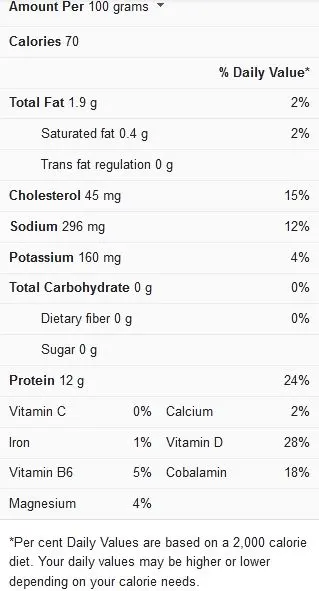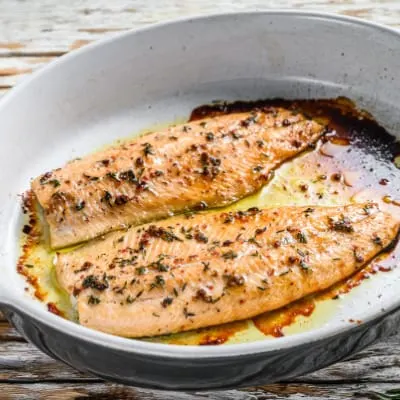Flounders are not particularly popular fish to eat. For one, they don’t appear to be extremely meaty, and they’re often thought to be difficult to clean or fillet. The truth is, if prepared and cooked properly, the gorgeous white flesh of a flounder may be delightful to eat.
This article describes the best ways to prepare a flounder in the oven, with added information on how to fillet a flounder, gut, and clean it so that it may be cooked whole. Nothing stops you from enjoying flounder recipes when familiar with great ways to cook them.

Flounder Nutrition Facts

Cooking Flounder in an Oven
Fish is by nature high in omega-3 fatty acids and moisture, making it an excellent option for baking or broiling. However, even a minute or two in the Oven too long causes the flounder to dry up quickly. As a result, it is important to pay close attention to your flounder recipe when preparing it in the Oven.
When cooking a flounder in the Oven, you can follow these easy steps for the best results:
Step 1: Preparing the Oven
If you’re baking the flounder fillet, preheat the Oven to 425℉ about 30 minutes ahead of time. If you wish to broil it, start preheating the broiler about 10 minutes ahead of time.
Broiling takes less than half the time of baking when it comes to preheating and cooking time; it’s also better for crisping the outside of fish, so use it if you’re breading the fillet or desire a crusted surface.
Step 2: Lining the Pan
Line a baking tray with foil, brush it with cooking oil, or grease the broiler rack with cooking oil to bake the flounder. If a thin, delicate, flaky fried flounder fillet sticks, there’s a good chance it’ll come apart when you try to pull it off the tray if you don’t grease it first.
Step 3: Seasoning the Flounder
Drizzle melted unsalted butter or frying oil over the flounder. Season liberally with salt and pepper, as well as any additional aromatics, herbs, spices, or flavoring agents you want to use. For spicy dishes, use blackening or Cajun seasoning mixes or a combination of dill, basil, tarragon, thyme, oregano, marjoram, and rosemary.
Try bread crumbs mixed with herbs, coarsely chopped pecans or pistachios, grated Parmesan cheese, or citrus zest in baked flounder. Baked fish with lemon, garlic, and butter is another option. Brush the top of your fish with honey mustard, Dijon mustard, or horseradish minced for a bite.
Step 4: Baking the flounder
Place the flounder on a parchment-lined baking tray or a broiler pan. To bake, position the fillet 4 to 5 inches below the heating element; to broil, place it 4 to 5 inches below the heating element.
A flounder fillet should be baked for 12 minutes or broiled for 6 minutes. It’s done when the flesh easily flakes away and is evenly opaque on the inside. Fish should be cooked to an internal temperature of at least 145 degrees Fahrenheit for safety reasons.
With a broad spatula, carefully remove the flounder from the tray or pan, firmly supporting it beneath.
How to fillet a flounder
Knowing how to cook a flounder is important, but knowing how to make fillets from flounders for an easier cooking process. For example, filling a flounder or other flatfish differs significantly from filleting a round fish like mackerel or cod. As a result, it is important to pay attention to the steps involved in the filleting process.
- Place the flounder on a cutting board with the top/mottled side facing up. Make a deep cut around the head with your filleting knife.
- Across the top of the tail, make a nick through the bone. Cut the tail up to the head following the nick you’ve made along one side of the backbone. Maintain proximity to the backbone with the knife.
- Only move the knife in one direction when filleting fish. Start slicing the flesh with the knife, cutting out from the backbone, and always keeping the bones in mind until you take the first fillet. Carry on with the second top fillet in the same manner.
- Turn the fish over to display the white belly side. Repeat the same steps as you did with the flounder on the opposite side.
When you have your flounder fillets, you’ll probably want to peel them before cooking them. This simple procedure is identical to skinning a fish such as cod or haddock.
Skinning the flounder fillets can be done in these three easy steps:
- Place the fillet on the chopping board with the thin end on the weaker side.
- With your weaker hand, pinch the narrow point of the fillet and cut a slit in the flesh to the skin, but not through the skin, with the knife blade angled away from your hand.
- Pull softly but firmly on the skin end with your weaker hand as you slide the knife back and forth over the skin at right angles to the fillet. The skin should peel off easily and cleanly this way.
Flavorful Flounder for the Oven (8 servings)

Ingredients
- 2 pounds of flounder fillets, rinsed and patted dry
- ¼ teaspoon of salt
- cooking spray
- Three tablespoons of lemon juice, divided
- ¼ cup of melted butter
- ½ cup of grated Parmesan cheese
- Three tablespoons of mayonnaise
- Three tablespoons of chopped green onions (optional)
Instructions
- Preheat the Oven to 375 ℉ (190 degrees C), coat a 9x13-inch baking dish using nonstick cooking spray.
- Season the flounder fillets on both sides with salt. Place in the baking dish that has been prepared. One tablespoon of lemon juice should then be brushed over the fillets.
- In a mixing dish, combine the remaining lemon juice, Parmesan cheese, melted butter, mayonnaise, and green onions; spread over the fillets.
- Bake flounder for 10 minutes in a preheated oven. Preheat the oven to broil and broil the fillets for 3 to 5 minutes, or until the tops are lightly browned.
This flounder recipe is packed with delicious flavors and can be a satisfying experience. For more ideas on cooking flounder in an oven, you can check out this video recipe.
Nutrition Information:
Yield:
8Serving Size:
1Amount Per Serving: Calories: 212Total Fat: 14gSaturated Fat: 6gTrans Fat: 0gUnsaturated Fat: 7gCholesterol: 86mgSodium: 671mgCarbohydrates: 1gFiber: 0gSugar: 0gProtein: 19g